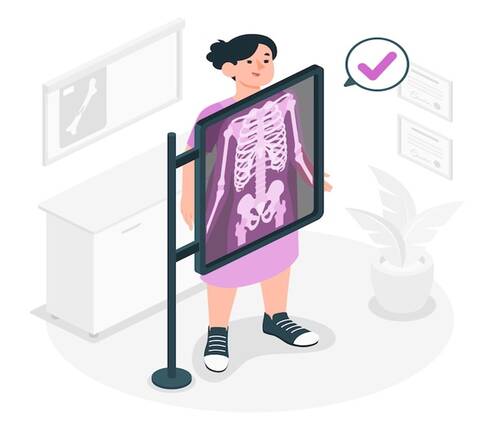A fractured sternum, often called a broken breastbone, is a painful injury that can complicate your daily life. The sternum is a flat bone in the center of your chest that protects important organs like the heart and lungs, and your ribs connect to it.
When this bone is injured, it often leads to discomfort and complications that can greatly affect daily life. Engaging in normal activities becomes challenging. Since the sternum is vital for breathing and maintaining posture, a fracture can make routine tasks difficult.
You may find it hard to lift what used to feel like a trivial weight. Exercising can become nearly impossible. Being aware of the causes, potential legal options for compensation, and symptoms of a fractured sternum can assist you through your recovery.
(more…)
Aging, Author Interviews, Frailty, JAMA, Orthopedics / 16.05.2024
Rutgers Study Finds Marked Increase in Fractures in Nursing Home Patients Started on Blood Pressure Meds
MedicalResearch.com Interview with:
Chintan V. Dave PharmD, PhD
Assistant Professor of Pharmacy and Epidemiology
Assistant Director
Rutgers Center for Pharmacoepidemiology and Treatment Science
Academic Director
Rutgers Center for Health Outcomes, Policy, and Economics
Rutgers University
New Brunswick, New Jersey
MedicalResearch.com: What is the background for this study?
Response: Our study examined the association between initiation of an antihypertensive medication and its correlation with fracture risk among older nursing home veterans.
(more…)
Aging, Author Interviews, Emergency Care, Lifestyle & Health, Orthopedics / 26.04.2023
Dog Walking Sends Thousands to Emergency Rooms Each Year
MedicalResearch.com Interview with:
Ridge Maxson
M.D. Candidate, Class of 2024
Johns Hopkins University School of Medicine
MedicalResearch.com: What is the background for this study? What are the main findings?
Response: Dog walking is an increasingly popular mode of physical activity for adults in the US, but its injury burden and associated risk factors are not fully understood. This study found that the 3 most common injuries sustained by adult dog walkers in the US were finger fracture, TBI, and shoulder sprain or strain. Dog walking-related injuries sent approximately 423,000 adults to US EDs between 2001 and 2020, with an annual average of more than 21,000 visits. During that 20-year period, the estimated annual injury incidence increased by more than 4-fold. Among injured dog walkers, older adults and women were particularly vulnerable to serious injury, such as fracture and TBI.
(more…)
Author Interviews, BMJ, Orthopedics / 20.01.2022
Wrist Fractures: Study Compares Casting to Surgical Fixation
MedicalResearch.com Interview with:
Prof. Matthew Costa
Professor of Orthopaedic Trauma
University of Oxford
Honorary Consultant Trauma Surgeon,
John Radcliffe Hospital, Oxford
MedicalResearch.com: What is the background for this study?
Response: Fixation with metal implants provides reliable functional outcomes for patients after a manipulation of a displaced fracture of the distal radius, but such surgery carries risk for the patient and is expensive.
A moulded plaster cast is a safer and cheaper intervention but may not provide the same functional outcome.
It is not known which of these treatments is superior. (more…)
Asthma, Author Interviews, BMJ, Osteoporosis / 21.10.2020
Oral and Inhaled Corticosteroids For Asthma Linked to Increased Risk of Osteoporosis
MedicalResearch.com Interview with:
Christos Chalitsios B.Sc, M.Sc PhD student
Funded by British Medical Association (BMA)
School of Medicine
Division of Respiratory Medicine
University of Nottingham
City Hospital,Nottingham
MedicalResearch.com: What is the background for this study?
Response: Inhaled (ICS) and oral (OCS) corticosteroids play a crucial role in the control of airway inflammation in asthma. Given that the use of ICS in asthma is likely to increase with the recent change in GINA guidance recommending combined long-acting-β2-agonists with ICS at step 1 and the upward trend in prescribing of OCS, we sought to clarify the link between steroids, osteoporosis and FF in patients with asthma, stratifying the risk by dose, number of courses and type of steroids. The prevalence of patients receiving at least one bisphosphonate was also calculated.
(more…)
Author Interviews, NEJM, Osteoporosis, UCSF / 19.08.2020
Bisphosphonates: Fragile Broken Bones vs Atypical Fractures
The benefits of bisphosphonates and other osteoporosis treatments, including the reduction of the devastating consequences of hip and other fractures...
Annals Internal Medicine, Author Interviews, Brigham & Women's - Harvard, Osteoporosis / 28.07.2020
Delays in Denosumab (Prolia®) Injections Linked to Increased Risk of Fractures
MedicalResearch.com Interview with:
Daniel Hal Solomon, MD, MPH
Associate Physician, Brigham and Women's Hospital
Professor of Medicine, Harvard Medical School
Brigham and Women's Hospital
Department of Medicine
Rheumatology, Immunology
Boston, MA 02115
Editor’s note: Prolia® is the trade name for denosumab.
MedicalResearch.com: What is the background for this study?
Response: We conducted this study to assess whether delays in denosumab (injections were associated with an increased risk of fractures. In a prior study, we found that the improvements in bone mineral density were reduced among patients who delayed injections.
(more…)
Author Interviews, JAMA, Orthopedics, Vitamin D / 26.12.2019
Vitamin D, With and Without Calcium, for the Prevention of Fracture
MedicalResearch.com Interview with:
Robert Clarke MD, FRCP, FFPH, FFPHI, MSc, DCH
Professor of Epidemiology and Public Health Medicine
Clinical Trial Service Unit (CTSU)
Nuffield Department of Population Health
University of Oxford
MedicalResearch.com: What is the background for this study?
Response: Approximately 1 in 2 women and 1 in 5 men aged 50 years or older will suffer from an osteoporotic fracture in their remaining lifetime. Hip fracture is the most serious type of osteoporotic fracture with an approximately 30% risk of death in the year following a hip fracture. Vitamin D is essential for optimal musculoskeletal health by promotion of calcium absorption, and mineralisation of osteoid tissue formation in bone and maintenance of muscle function. Low vitamin D status causes secondary hyperparathyroidism, bone loss and muscle weakness. Observational studies have reported that lower blood concentrations of vitamin D are associated with higher risks of falls and fractures.
Combined supplementation with 800 IU/day vitamin D and 1200 mg/day calcium has been recommended for prevention of fractures in older adults living in institutions and in those with low vitamin D status. However, previous trials and meta-analyses of vitamin D alone, or in combination with calcium for prevention of fracture in either community-dwelling or general population settings reported conflicting results, with some reporting protective effects against fractures, but others demonstrated no beneficial effects. However, most of the previous trials had only limited power to detect differences in risk of fracture predicted by the observational studies, largely because of a combination of small sample size, relatively low equivalent daily doses of vitamin D, intermittent dosing regimens (>1 month), and short duration of follow-up. In addition, interpretation of the results of previous meta-analyses of such trials is complicated by use of variable inclusion criteria, inappropriate statistical methods, inclusion of multiple small trials with very few fracture events, in addition to failure to report achieved differences in blood 25(OH)D concentrations.
We summarised the available evidence to guide clinical practice and future research, by conducting parallel meta-analyses of:
- (i) observational studies of risks of fracture associated with prolonged differences in blood concentrations of 25(OH)D;
- (ii) randomised trials of vitamin D alone versus placebo or no treatment for prevention of fracture; and
- (iii) randomised trials of calcium and vitamin D versus placebo or no treatment for prevention of fracture.In addition, we reviewed the design of the ongoing randomised trials assessing the effects of higher doses of vitamin D alone or in combination with calcium for prevention of fracture.
Author Interviews, Orthopedics, PLoS / 12.08.2019
Treating Shoulder Fracture with a Sling, Not Surgery
MedicalResearch.com Interview with:
Prof. Inger Mechlenburg, PhD, DMSc
Orthopaedic Department, Aarhus University Hospital
Department of Clinical Medicine
Aarhus University
MedicalResearch.com: What is the background for this study? What are the main findings?
Response: Traditionally, displaced 2-part humerus fractures have been operatively treated using a metal plate and screws. However, there are no studies showing a benefit of operation of those fractures. Therefore, we were interested in investigating, in a direct comparison between operation and non-operative treatment, whether there was a difference in patient-reported function, pain and health-related quality of life two years after the fracture.
In this Nordic research collaboration http://nitep.eu/en/ between Finland, Sweden, Estonia and Denmark we showed that there is no difference in functional results between operative and non-operative treatment in persons aged 60 or more with displaced proximal humerus fractures.
In the study, only fractures with a significant displacement between bone fragments were included. In the non-operative treatment group, patients used a collar and cuff sling for three weeks and underwent instructed physiotherapy. (more…)
Author Interviews, Brigham & Women's - Harvard, JAMA, Orthopedics, Osteoporosis, Surgical Research / 15.05.2019
Roux-en-Y Gastric Bypass Linked to More Hip Fractures
MedicalResearch.com Interview with:
Elaine W. Yu, MD, MMSc
Assistant Professor, Harvard Medical School
Director, Bone Density Center
Endocrine Unit, Massachusetts General Hospital
MedicalResearch.com: What is the background for this study? What are the main findings?
Response: Roux-en-Y gastric bypass (RYGB) is a popular surgical weight loss procedure. We have previously shown that gastric bypass leads to rapid high-turnover bone loss.
Bariatric procedures are being increasingly performed in older adults, and the clinical consequences of gastric bypass-associated skeletal changes in this vulnerable population have been unclear to date. Thus, we used Medicare claims data to investigate fracture risk among older adults after gastric bypass, and in comparison to adults who received another bariatric procedure called adjustable gastric banding (AGB), which is thought to have fewer negative bone effects.
In our analysis, we found that patients undergoing Roux-en-Y gastric bypass were 73% more likely to fracture than those undergoing AGB. Importantly, we found that hip fracture risk increased nearly 180% after RYGB, and that fracture rates in patients aged 65 or older were similar to the overall group. (more…)
Author Interviews, Opiods, Orthopedics / 18.03.2019
Upper Arm Fractures: Comordid Conditions Linked to More Opioids and Longer Hospital Stays
MedicalResearch.com Interview with:
Paul Cagle, Jr. MD
Assistant Professor of Orthopedic Surgery
Icahn School of Medicine at Mount Sinai
MedicalResearch.com: What is the background for this study? What are the main findings ie What are some of the significant comorbidities?
Response: In this study our goal was to better understand what medical issues (medical comorbidities) can cause trouble or issue for patients with a proximal humerus fracture (shoulder fracture). To tackle this issue we used a large national sample of patients and sorted our the different medical issues the patients had.
We found that patients with increased medical issues had longer hospital stays and higher use of opioid medications (pain medications).
(more…)
Author Interviews, BMJ, Orthopedics / 28.01.2019
Shorter Casting Period May Be Sufficient For Many Ankle Fractures
MedicalResearch.com Interview with:
Tero Kortekangas, MD, PhD
Orthopaedic trauma surgeon
Oulu University Hospital
Oulu, Finland
MedicalResearch.com: What is the background for this study? What are the main findings?
Response: Isolated, stable, Weber B type fibula fracture is by far the most common type of ankle fracture. Traditionally these fractures are treated with below the knee cast for six weeks. Although the clinical outcome of this treatment strategy has been shown to be generally favourable, prolonged cast immobilisation is associated with increased risk of adverse effects, prompting attempts to streamline the treatment. However, perhaps because of absence of high quality evidence on the effectiveness and safety of more simple non-operative treatment strategies, the current tenet of six weeks of cast immobilisation still remains the “gold standard” treatment of stable Weber B type fractures.
(more…)
Author Interviews, Bone Density, NEJM, Orthopedics / 21.12.2018
Reclast, Zometa (zoledronate) Reduced Fractures in Osteopenic Older Women
MedicalResearch.com Interview with:
Prof Ian Reid MD
Faculty of Medical and Health Sciences
University of Auckland
Auckland New Zealand
MedicalResearch.com: What is the background for this study?
Response: Bisphosphonates prevent fractures in patients with osteoporosis, but their efficacy in women with osteopenia is unknown. Most fractures in postmenopausal women occur in osteopenic patients, so therapies with efficacy in osteopenia are needed.
(more…)
Author Interviews, Depression, Hip Fractures, Lancet / 06.12.2018
Fluoxetine (Prozac) Did Not Reduce Risk of Depression After Stroke, But Did Raise Risk of Fractures
MedicalResearch.com Interview with:
Prof. Gillian Mead
Chair of Stroke and Elderly Care Medicine
Prof. Martin Dennis
Chair of Stroke Medicine
Centre for Clinical Brain Sciences
The University of Edinburgh
MedicalResearch.com: What is the background for this study?
Response: We are both practicing stroke physicians as well as clinical trialists. Therefore our interest in this area was triggered by the exciting results of the FLAME trial in 2011. This appeared to indicate that fluoxetine might boost the recovery of stroke patients. Potentially this was very important given the increasing numbers of people having disability due to stroke, and the fact that fluoxetine is inexpensive and could be introduced very easily into clinical practice. We were further encouraged by the large numbers of small RCTs we identified when we carried out a Cochrane systematic review on the topic. These trials provided more evidence of potential benefit but there was evidence that trials of greater quality showed less benefit, and benefits were greater in patients who were depressed. We felt there was a need for more evidence derived from much larger numbers of patients.
(more…)
Author Interviews, Genetic Research, Osteoporosis, PLoS, Stanford / 29.07.2018
Genetic Testing Could Identify Individuals At Risk of Osteoporosis
MedicalResearch.com Interview with:
Stuart Kim PhD
Professor of Developmental Biology, Emeritus
Bio-X Affiliated Faculty
James H. Clark Center
Stanford University
MedicalResearch.com: What is the background for this study? What are the main findings?
Response: Osteoporosis is caused by a reduction in bone mass, and leads to a high incidence of bone fracture because the weakened bone is less able to withstand the stress of slips and falls. Osteoporosis affects millions of elderly, is responsible for as many as 50% of fractures in women and 25% of fractures in men over the age of 50, and accounts for $19 billion in annual health care costs in the US. Identification of people with an increased genetic risk for osteoporosis could reduce the incidence of bone fracture. Low BMD is also a risk factor for stress fractures. For athletes and military personnel undergoing harsh rigors of training, stress fractures are common injuries that limit playing time, military effectiveness and competitive success.
Using data from UK Biobank, a genome-wide association study identified 1,362 independent SNPs that clustered into 899 loci of which 613 are new. These data were used to train a genetic algorithm using 22,886 SNPs as well as height, age, weight and sex as predictors. Individuals with low genetic scores (about 2% of those tested) showed a 17-fold increase in risk for osteoporosis and about a 2-fold increase in risk of fractures. (more…)
Author Interviews, Hip Fractures, Mineral Metabolism / 17.04.2017
Low Magnesium May Be Linked To Increased Risk of Hip Fractures
MedicalResearch.com Interview with:
Dr Setor Kunutsor Ba(Legon), MBChB(Legon), MA(Cantab), PhD(Cantab)
Research Fellow
Musculoskeletal Research Unit
University of Bristol
MedicalResearch.com: What is the background for this study?
Response: Bone fractures are one of the leading causes of disability and ill health especially among the ageing population and are a burden to health care systems. There is established evidence that calcium and vitamin D play an important role in bone health.
Magnesium is an essential trace element, being the second most abundant intracellular cation after potassium and the fourth most abundant cation in the body. It serves several important functions in the body, which include protein synthesis, nucleic acid synthesis, enzymatic reactions, and has also been shown to be cardio-protective. It is also an important component of bone, with majority (67 percent) of total body magnesium known to be found in the bone tissue. There have been suggestions from both human and animal experiments that magnesium may have a beneficial effect on bone health; however, its relationship with fractures is not very certain.
(more…)
Author Interviews, BMJ, Orthopedics, Technology / 26.10.2016
Low-Intensity Ultrasound Not Effective In Accelerating Healing of Tibial Fractures
MedicalResearch.com Interview with:
Jason Busse PhD
Associate Professor, Department of Anesthesia
McMaster University
Hamilton, ON
MedicalResearch.com: What is the background for this study? What are the main findings?
Response: Our group previously reviewed the evidence regarding the effectiveness of low-intensity pulsed ultrasound (LIPUS) for fracture healing. We found moderate to very low quality evidence for LIPUS in accelerating functional recovery among patients with fracture, and that most trials only explored effects on surrogate outcomes (e.g. radiographic healing); only five of 13 trials directly assessed functional end points - of these, one was positive. We concluded that large trials of high methodological quality, focusing on patient important outcomes such as quality of life and return to function, were needed to establish the role of LIPUS in fracture healing.
We have now completed such a study. Our large, international trial of LIPUS for surgically managed tibial fractures found the addition of LIPUS does not improve functional recovery or accelerate radiographic healing.
(more…)
Author Interviews, Columbia, NEJM, Orthopedics, Osteoporosis / 21.09.2016
Romosozumab Has Potential To Reduce New Vertebral Fractures at 12 Months
MedicalResearch.com Interview with:
Felicia Cosman, M.D.
Medical Director of the Clinical Research Center
Helen Hayes Hospital
Professor of Medicine
Columbia University College of Physician and Surgeons
New York
Editor-in-Chief, Osteoporosis International
MedicalResearch.com: What is the background for this study? What are the main findings?
Response: Amgen and UCB presented detailed data from the Phase 3 FRAME study in an oral session at ASBMR 2016, and the data were also published in the New England Journal of Medicine. Additionally, the FRAME abstract has been awarded the 2016 ASBMR Most Outstanding Clinical Abstract Award. The FRAME data show significant reductions in both new vertebral and clinical fractures in postmenopausal women with osteoporosis.
Patients receiving a monthly subcutaneous 210 mg dose of romosozumab experienced a statistically significant 73 percent reduction in the relative risk of a vertebral (spine) fracture through 12 months, the co-primary endpoint, compared to those receiving placebo (fracture incidence 0.5 percent vs. 1.8 percent, respectively [p<0.001]). By six months, new vertebral fractures occurred in 14 romosozumab and 26 placebo patients; between six to 12 months, fractures occurred in two versus 33 additional patients in each group, respectively.
Patients receiving romosozumab experienced a statistically significant 36 percent reduction in the relative risk of a clinical fracture, a secondary endpoint, through 12 months compared to those receiving placebo (fracture incidence 1.6 percent vs. 2.5 percent, respectively [p=0.008]).
In patients who received romosozumab in year one, fracture risk reduction continued through month 24 after both groups transitioned to denosumab treatment through the second year of the study: there was a statistically significant 75 percent reduction in the risk of vertebral fracture at month 24 (the other co-primary endpoint) in patients who received romosozumab followed by denosumab vs. placebo followed by denosumab (fracture incidence 0.6 percent vs. 2.5 percent, respectively [p<0.001]).
Clinical fractures encompass all symptomatic fractures (both non-vertebral and painful vertebral fractures; all clinical fractures assessed in the FRAME study were symptomatic fragility fractures. A 33 percent reduction in relative risk of clinical fracture was observed through 24 months after patients transitioned from romosozumab to denosumab compared to patients transitioning from placebo to denosumab (nominal p=0.002, adjusted p=0.096).
(more…)
Author Interviews, JAMA, Orthopedics / 12.09.2016
Key Risk Factors of Non-Healing Bone Fractures Identified
MedicalResearch.com Interview with:
R. Grant Steen, PhD
Medical Affairs,
Bioventus LLC
Durham, North Carolina
MedicalResearch.com: What is the background for this study? What are the main findings?
Response: When we started this research, it was really only guesswork as to how big a problem fracture nonunion really is. What we've done is to work with an enormous database of patient health claims, with two goals.
First, we wanted to characterize how common fracture nonunion is among patients across a wide age range.
Second, we wanted to identify risk factors that make a patient more likely to have problems healing.
We've now succeeded in both aims. We know that roughly 5% of fracture patients will go to nonunion, and we know a whole host of risk factors that predispose them to do so.
Most of the risk factors that we've identified—with a few exceptions—would not be a surprise to physicians who treat fracture patients. However, what we've done is to put all of these risk factors in a broader context, so that we know which risk factors are most important and which are less so.
For example, it has been known for a long time that smoking is a risk factor for nonunion. What we've shown is that, in the scheme of things, it's not all that important. Let me be more precise here, because this is an important point. If all you know about a patient is that they smoke, we've shown that smoking is associated with a 62% increase in risk of nonunion. That's a lot. But, as you learn more about that patient and can factor that new knowledge into a risk prediction, it turns out that smoking, all by itself, increases the risk of nonunion by only about 20%. However, smoking is a surrogate marker for a range of other risk factors that also increase risk, including male gender, cardiovascular disease, obesity, vitamin D deficiency, alcoholism, and so on. Once you factor these separate risk factors into your new nonunion prediction, you have a much more nuanced—and probably much more accurate—prediction of nonunion risk.
(more…)
Author Interviews, Frailty, Hip Fractures, JAMA, Pharmacology / 22.08.2016
Patients Remain On High Risk Drugs Even After A Fragility Fracture
MedicalResearch.com Interview with:
Jeffrey Munson, MD, MSCE
Assistant Professor
The Dartmouth Institute for Health Policy & Clinical Practice
Assistant Professor, Department of Medicine
Geisel School of Medicine at Dartmouth
MedicalResearch.com: What is the background for this study?
Response: Fragility fractures due to osteoporosis are a common and costly event among older Americans. Patients who experience one fragility fracture are at increased risk to have a second fracture. Our group is interested in exploring ways in which the risk of a second fracture could be reduced.
In this paper, we studied prescription drug use both before and after fracture. We know many prescription drugs have been shown to increase the risk of fracture, but we don’t know whether doctors try to reduce the use of these drugs after a fracture has occurred. Our study was designed to answer this question.
(more…)
Author Interviews, JAMA, Surgical Research / 21.07.2016
Over 50% Reduction in Facial Fractures from Car Accidents With Combined Seat Belt and Air Bag use
MedicalResearch.com Interview with:
Dr. David A. Hyman, MD
Division of Otolaryngology–Head and Neck Surgery
Department of Surgery
University of Wisconsin School of Medicine and Public Health
Madison
MedicalResearch.com: What is the background for this study? What are the main findings?
Response: Motor vehicle collisions represent a significant source of facial fractures seen at US trauma centers. In the last few decades there have been significant advances in airbag technology as well as a national legislative push regarding seat belt use which has led to increased safety device use. With these trends, we sought to assess the incidence of facial fractures in patients who present to US trauma centers as well as to analyze what effect restraint devices have on the likelihood of facial fractures after motor vehicle collisions. This analysis was performed using National Trauma Data Bank data from 2007-2012. We found the incidence of at least one facial fracture after a motor vehicle collision was 10.9% with nasal fracture being the most common facial fracture. Based on our analysis of more than 56 thousand patients with a facial fracture, we found that use of an airbag alone reduced the likelihood of a facial fracture by 18% while use of a seat belt alone reduced likelihood by 43%. Use of both reduced the likelihood of facial fractures in a crash by 53%. Younger age, male sex, and use of alcohol increased the likelihood of facial fracture.
(more…)
Author Interviews, Hip Fractures, Medical Imaging, Osteoporosis / 25.01.2016
Normal Bone Density in Men Does Not Prevent Fractures—Fall Prevention Still Needed
MedicalResearch.com Interview with:
Margaret L. Gourlay, MD, MPH
Assistant Professor
UNC Department of Family Medicine
Chapel Hill, NC 27599-7595
Medical Research: What is the background for this study? What are the main findings?
Dr. Gourlay: While clinical practice guidelines universally recommend bone density screening for fracture prevention in women aged 65 years and older, minimal data exist to guide bone density screening in older men. We studied how often bone density screening tests should be ordered in men, using data from the Osteoporotic Fractures in Men (MrOS) Study. MrOS is the largest and longest-running (since 2000) US study of bone density and fracture in men aged 65 and older.
After peak bone mass is reached in young adulthood, both men and women lose bone density as they get older. Based on our earlier findings in older women, we expected that men aged 65 and older with higher bone density T-score measurements (T-score >-1.50) on a first (baseline) bone density test would have a substantially longer estimated time to develop the lowest level of bone density (osteoporosis) than men with better baseline measurements. Clinicians want to know the time to osteoporosis because they prescribe osteoporosis treatments to prevent future fractures in elderly patients.
As expected, we found that the men with higher baseline bone density had a much slower transition to osteoporosis compared to men with lower bone density. In fact, only nine out of 4203 (0.2%) of men with higher baseline bone density developed osteoporosis after an average of 8.7 years of bone density follow-up. That was much lower than we expected and is good news for men who have favorable scores on their first bone density test. Men who had lower baseline bone density measurements developed osteoporosis faster.
Unfortunately, maintaining bone density above the osteoporosis range did not guarantee that men remained fracture-free. Most of the major osteoporotic fractures (broken hip, spine, wrist or upper arm/shoulder) occurred in men who did not have osteoporosis. This might be because they had accidents or injuries that broke their bones despite their bone density being above the thinnest range.
(more…)
MedicalResearch.com Interview with:
Prof. Jonathan M. Hodgson
School of Medicine and Pharmacology
Royal Perth Hospital
University of Western Australia
Perth, Australia
MedicalResearch What is the background for this study? What are the main findings?
Prof. Hodgson: Flavonoids are a class of phytochemicals present at high levels in tea. Observational studies have found that higher tea and flavonoid intakes are associated with higher bone mineral density. However, the relationships of tea and flavonoid intakes with fracture risk are not clear. We therefore examined the relationship of black tea drinking and flavonoid intake with fracture risk in a population of women aged over 75 years followed for 10 years. We found that a higher intake of black tea and particular classes of flavonoids, some of which are derived primarily from tea, were associated with lower risk of fracture-related hospitalizations in these elderly women.
(more…)
Author Interviews, BMJ, Brigham & Women's - Harvard, Menopause, Orthopedics / 26.06.2015
Menopausal SSRIs Increases Risk of Bone Fractures
MedicalResearch.com Interview with:
Dr Matthew Miller
Department of Health Science Northeastern University
Department of Health Policy and Management,
Harvard T.H. Chan School of Public Health Harvard University
Boston, Massachusetts
and Yi-Han Sheu
Department of Epidemiology
Harvard T.H. Chan School of Public Health
Harvard University Boston, Massachusetts
Medical Research: What is the background for this study?
Response: Selective serotonin reuptake inhibitors (SSRIs) were recently approved by the FDA to treat vasomotor symptoms associated with menopause. No prior study has directly examined whether fracture risk is increased among perimenopausal women who initiate SSRIs or among a population of women without mental disorders more generally..
Medical Research: What are the main findings?
Response: We found that SSRIs treatment for non-psychiatric conditions at doses customarily used to treat depression is, all else equal, associated with higher rates of fractures -- an effect that first became evident several months after beginning treatment and, importantly, persisted over the five year study period.
(more…)
Author Interviews, JAMA, Orthopedics, Surgical Research / 11.03.2015
Nonsurgical Treatments May Equal Surgery For Many Broken Shoulders
 MedicalResearch.com Interview with:
Prof. Amar Rangan
Clinical Professor, Trauma & Orthopaedic Surgery
School of Medicine & Health, Durham University & Consultant Orthopaedic Surgeon
The James Cook University Hospital Middlesbrough
Medical Research: What is the background for this study? What are the main findings?
Prof. Rangan: The majority of fractures of the proximal humerus (broken shoulders) occur in people older than 65 years. Although surgical treatment is being increasingly used for the more serious (displaced) fractures, it has been unclear whether surgical intervention (fracture fixation or humeral head replacement) produces consistently better outcomes than non-surgical treatment (arm-sling); both followed by physiotherapy.
Our multicentre randomized controlled trial (ProFHER), funded by the UK National Institute for Health Research’s Health Technology Assessment Programme, recruited 250 patients aged 16 years or older (mean age, 66 years) who presented at the orthopedic departments of 32 acute UK National Health Service hospitals between September 2008 and April 2011 after sustaining the most common types of acute displaced fracture of the proximal humerus.
Data for 231 patients (92.4% of 250) included in the primary analysis showed that there was no significant difference between the two treatment groups over two years or at 6, 12 and 24 months follow-up in self-reported pain and function scores. Nor were there significant differences on measures of health-related quality of life, complications related to surgery or shoulder fracture, later surgery or treatment for these complications, and death.
(more…)
MedicalResearch.com Interview with:
Prof. Amar Rangan
Clinical Professor, Trauma & Orthopaedic Surgery
School of Medicine & Health, Durham University & Consultant Orthopaedic Surgeon
The James Cook University Hospital Middlesbrough
Medical Research: What is the background for this study? What are the main findings?
Prof. Rangan: The majority of fractures of the proximal humerus (broken shoulders) occur in people older than 65 years. Although surgical treatment is being increasingly used for the more serious (displaced) fractures, it has been unclear whether surgical intervention (fracture fixation or humeral head replacement) produces consistently better outcomes than non-surgical treatment (arm-sling); both followed by physiotherapy.
Our multicentre randomized controlled trial (ProFHER), funded by the UK National Institute for Health Research’s Health Technology Assessment Programme, recruited 250 patients aged 16 years or older (mean age, 66 years) who presented at the orthopedic departments of 32 acute UK National Health Service hospitals between September 2008 and April 2011 after sustaining the most common types of acute displaced fracture of the proximal humerus.
Data for 231 patients (92.4% of 250) included in the primary analysis showed that there was no significant difference between the two treatment groups over two years or at 6, 12 and 24 months follow-up in self-reported pain and function scores. Nor were there significant differences on measures of health-related quality of life, complications related to surgery or shoulder fracture, later surgery or treatment for these complications, and death.
(more…)
Author Interviews, Gender Differences, Orthopedics, Race/Ethnic Diversity, UCLA / 08.04.2014
Higher Social Class Linked To Lower Risk of Bone Fractures
 MedicalResearch.com Interview with:
Dr. Carolyn Crandall, M.D.
Division of General Internal Medicine,
David Geffen School of Medicine at University of California,
Los Angeles, CA, 90024, USA
MedicalResearch.com: What are the main findings of the study?
Dr. Crandall: We found that higher social class was linked with a lower risk of fractures among non-Caucasian women. Compared with non-Caucasian women who had no more than a high school education, those with at least some postgraduate education had nearly 90% lower rates of non-traumatic fracture. These results were present even after we accounted for income.
(more…)
MedicalResearch.com Interview with:
Dr. Carolyn Crandall, M.D.
Division of General Internal Medicine,
David Geffen School of Medicine at University of California,
Los Angeles, CA, 90024, USA
MedicalResearch.com: What are the main findings of the study?
Dr. Crandall: We found that higher social class was linked with a lower risk of fractures among non-Caucasian women. Compared with non-Caucasian women who had no more than a high school education, those with at least some postgraduate education had nearly 90% lower rates of non-traumatic fracture. These results were present even after we accounted for income.
(more…)
Author Interviews, Hip Fractures, JAMA, Orthopedics / 25.09.2013
Bone Mineral Density: Does Repeat Testing Improve Fracture Risk Prediction?
 MedicalResearch.com Interview with:
Sarah D. Berry MD MPH
Institute for Aging Research, Hebrew Senior Life
Boston, Massachusetts
MedicalResearch.com: What are the main findings of the study?
Dr. Berry: Repeating a bone mineral density (BMD) screening test in 4 years provided little additional value beyond baseline BMD when assessing fracture risk. Also, the second BMD measure resulted in little change in risk classification that is commonly used in clinical management of osteoporosis.
(more…)
MedicalResearch.com Interview with:
Sarah D. Berry MD MPH
Institute for Aging Research, Hebrew Senior Life
Boston, Massachusetts
MedicalResearch.com: What are the main findings of the study?
Dr. Berry: Repeating a bone mineral density (BMD) screening test in 4 years provided little additional value beyond baseline BMD when assessing fracture risk. Also, the second BMD measure resulted in little change in risk classification that is commonly used in clinical management of osteoporosis.
(more…)














